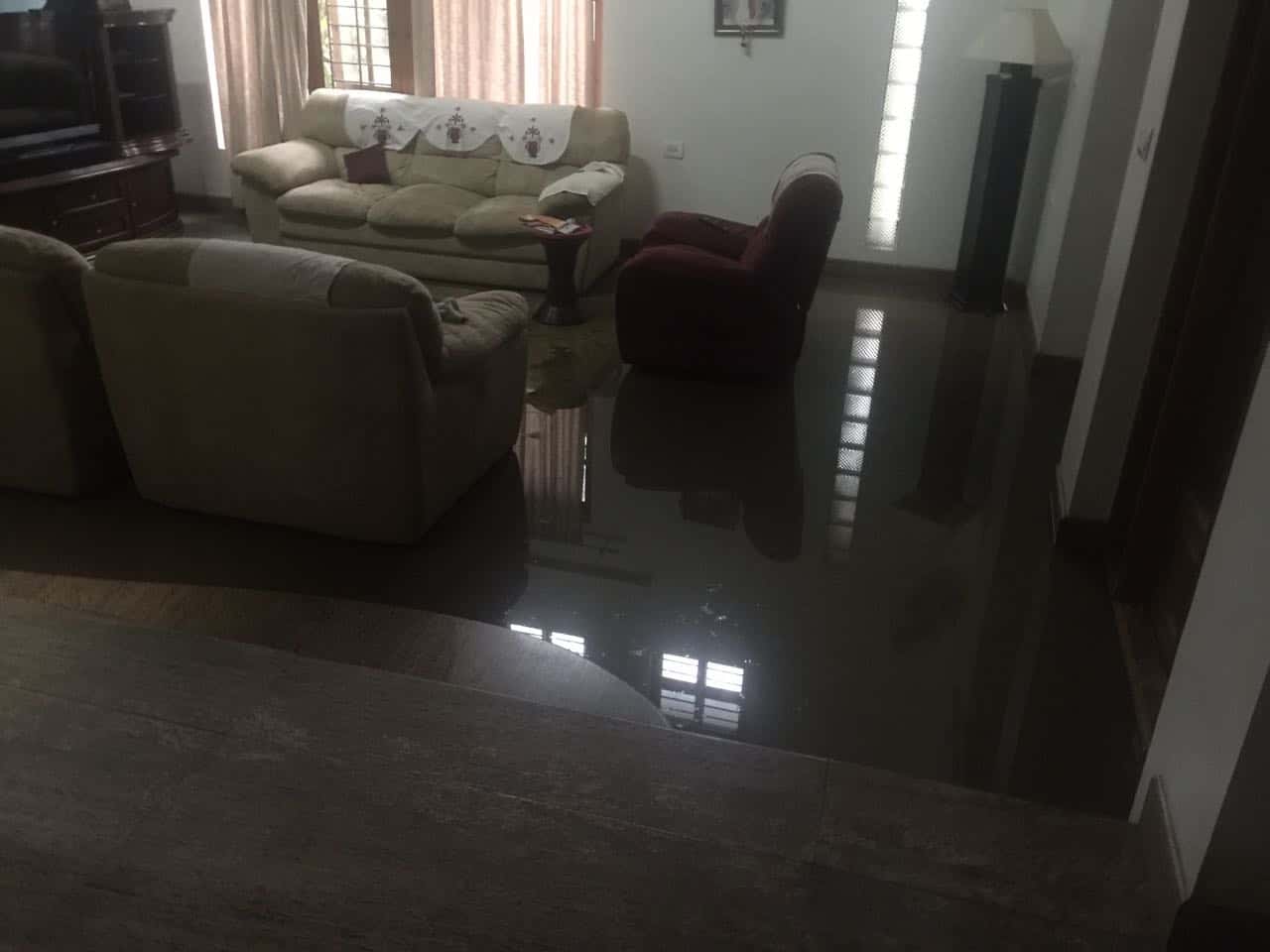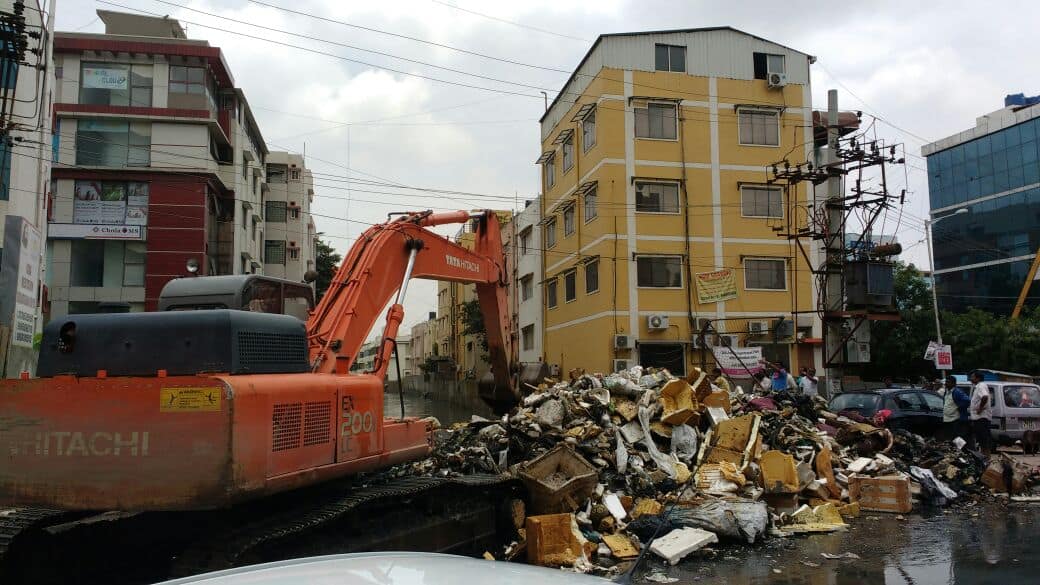Independence Day 2017 turned out to be a bright, sunny, yet cool, day – a typical Bengaluru day, it would appear. Yet, that morning we woke up to a rapidly flowing river outside our house that had completely submerged the main road leading into S.T. Bed Layout, Koramangala. A few hapless souls could be seen wading against the tide in at least a foot of water. Our compound was flooded, too. And murky water had entered many houses in more low-lying parts of the neighbourhood.
A walk around the area a little before noon on Tuesday revealed that some roads were still water-logged and garbage, as well as at least one dead rodent, was strewn here and there, carried along no doubt by the murky liquid that had obviously overflowed from the stormwater drain that borders the layout.

Water enters low-lying houses in the neighborhood. Pic: Ravi Kumar
Further afield, on the bridge over the stormwater drain at the entrance to the layout, the authorities were belatedly at work with dredgers pulling out the accumulated pile of stinking garbage and debris that had been a huge, disgusting eyesore for weeks – and not for the first time. A local television channel had broadcast a story on the pathetic state of the drain just last month; residents who had gathered to speak to the crew had recounted to the media professionals (again, not for the first time) the long-standing problems with the drain, which carries everything but rain water most of the time.

Garbage and debris being dredged out of the SWD around midday on August 15, 2017. Pic: Ammu Joseph
Of course, irresponsible citizens are also to be blamed for dumping waste in large and small drains meant for rainwater, not connecting their buildings to sewage drains, and much else.
Over the past several months the authorities have allegedly been “remodelling” the section of the storm water drain bordering the layout, which passes through what is known as the Koramangala Valley. Many crores of rupees have been allocated to the project. The “retaining” walls built so far are not very reassuring, visibly weak and not even upright even now, when they are relatively new. A portion of it is already missing and could well have enabled the gushing water, mush and muck to flood the area today.
The fact that roadside drains are invariably clogged with garbage and sludge, despite efforts by at least some residents to keep them clean, adds to the problem. And, of course, the inevitable delays in undertaking pipe-laying and other such civic works that result in multiple roads being dug up simultaneously just before and during the rainy season – the situation in several parts of Koramangala at present – make things worse.
BDA’s original sin: Residential layout on a tankbed
The original sin (at least as far as this particular layout is concerned) was, of course, that the Bangalore Development Authority created a residential layout on what was originally a tank bed–one of the hundreds of tanks, or water bodies, that Bengaluru was blessed with, thanks (from most accounts) to the farsightedness of earlier rulers like Nadaprabhu Kempe Gowda who recognised that it was important to compensate for the fact that the city had no natural water source, like a river. The continued and continuing destruction of the natural drainage system, thanks to unbridled encroachment of and rampant construction on wetlands and Raja Kaluves (the local word for storm water drains), is well-documented by scientists and other researchers as well as the media.
In fact, the vulnerability of this layout to flooding has been exacerbated by the fact that the level of the adjoining land, which was low-lying wetland, was systematically raised by dumping debris there over a couple of years (more than a decade ago) and then levelling it to create a private layout (known as Shanthinagar) where large apartment complexes are currently being built. The problems are well known. The question is whether anyone is going to do anything to change the situation.

The corpse of a dead dog, that came out from a drain during flood on 80 ft road. Pic: Ammu Joseph
Meanwhile, late night on Independence Day, electricity supply was yet to be restored. Intermittent rain from the evening onwards was causing further anxiety. And residents were desperately trying to figure out how to remove the slush from their houses, compounds and sumps (underground water storage tanks), and wondering when fresh water would be available.
The morning after the deluge
Battalions of pourakarmikas were out in different parts of S.T. Bed Layout on Wednesday morning, trying their best – with bare hands and rudimentary, inadequate equipment – to clear the streets of the slush left behind by yesterday’s flood. Anxious residents were getting murky water pumped out of their houses, basement garages and compounds. The few families living in makeshift shelters on empty plots were hanging wet clothes and other belongings out to dry. The playground and children’s park were still under water.
The worst-affected section of the layout (between 6th and 8th Mains) appears to have been flooded with water gushing in through two neighbouring plots on 1st Main, abutting the storm water drain. Part of the rear wall of one of them, with what appears to be an uninhabited house, had evidently collapsed, allowing the drain to overflow into the layout. An empty plot just a few numbers down also let water in.
Water also poured into 1st Main through the compound of a building just a few plots short of the bridge near Maharaja Restaurant (with more than the legally permissible number of floors), which turned out not to have a back wall at all!
Many things are obviously rotten in the state of Namma Bengaluru. Platitudes and empty promises from the so-called people’s representatives indulging in disaster tourism are not enough to set them right.
I live on 13A main for the past 14 years and has faced similar problem twice before.13A main becomes a fast flowing river whenever there is a cloud burst and all the houses on either side get flooded.Our basement got flooded and we incurred heavy losses because our cars got totally submerged and had to be salvaged.Electrical system was totally damaged and we had to be at the mercy of the Elecricity Board.They did their job soon enough once the water was drained out.The problem is the clogged drains.Please take note.